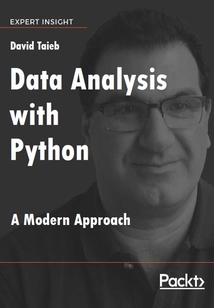舉報 

會員
Data Analysis with Python
最新章節:
Index
DataAnalysiswithPythonoffersamodernapproachtodataanalysissothatyoucanworkwiththelatestandmostpowerfulPythontools,AItechniques,andopensourcelibraries.IndustryexpertDavidTaiebshowsyouhowtobridgedatasciencewiththepowerofprogrammingandalgorithmsinPython.You'llbeworkingwithcomplexalgorithms,andcutting-edgeAIinyourdataanalysis.Learnhowtoanalyzedatawithhands-onexamplesusingPython-basedtoolsandJupyterNotebook.You'llfindtherightbalanceoftheoryandpractice,withextensivecodefilesthatyoucanintegraterightintoyourowndataprojects.Explorethepowerofthisapproachtodataanalysisbythenworkingwithitacrosskeyindustrycasestudies.Fourfascinatingandfullprojectsconnectyoutothemostcriticaldataanalysischallengesyou’relikelytomeetintoday.ThefirstoftheseisanimagerecognitionapplicationwithTensorFlow–embracingtheimportancetodayofAIinyourdataanalysis.Thesecondindustryprojectanalysessocialmediatrends,exploringbigdataissuesandAIapproachestonaturallanguageprocessing.Thethirdcasestudyisafinancialportfolioanalysisapplicationthatengagesyouwithtimeseriesanalysis-pivotaltomanydatascienceapplicationstoday.Thefourthindustryusecasedivesyouintographalgorithmsandthepowerofprogramminginmoderndatascience.You'llwrapupwithathoughtfullookatthefutureofdatascienceandhowitwillharnessthepowerofalgorithmsandartificialintelligence.
目錄(87章)
倒序
- 封面
- 版權頁
- Why subscribe?
- PacktPub.com
- Contributors
- About the author
- About the reviewers
- Packt is searching for authors like you
- Preface
- Why am I writing this book?
- Who this book is for
- What this book covers
- To get the most out of this book
- Get in touch
- Chapter 1. Programming and Data Science – A New Toolset
- What is data science
- Is data science here to stay?
- Why is data science on the rise?
- What does that have to do with developers?
- Putting these concepts into practice
- Deep diving into a concrete example
- Data pipeline blueprint
- What kind of skills are required to become a data scientist?
- IBM Watson DeepQA
- Back to our sentiment analysis of Twitter hashtags project
- Lessons learned from building our first enterprise-ready data pipeline
- Data science strategy
- Jupyter Notebooks at the center of our strategy
- Summary
- Chapter 2. Python and Jupyter Notebooks to Power your Data Analysis
- Why choose Python?
- Introducing PixieDust
- SampleData – a simple API for loading data
- Wrangling data with pixiedust_rosie
- Display – a simple interactive API for data visualization
- Filtering
- Bridging the gap between developers and data scientists with PixieApps
- Architecture for operationalizing data science analytics
- Summary
- Chapter 3. Accelerate your Data Analysis with Python Libraries
- Anatomy of a PixieApp
- Summary
- Chapter 4. Publish your Data Analysis to the Web - the PixieApp Tool
- Overview of Kubernetes
- Installing and configuring the PixieGateway server
- Summary
- Chapter 5. Python and PixieDust Best Practices and Advanced Concepts
- Use @captureOutput decorator to integrate the output of third-party Python libraries
- Increase modularity and code reuse
- Run Node.js inside a Python Notebook
- Summary
- Chapter 6. Analytics Study: AI and Image Recognition with TensorFlow
- What is machine learning?
- What is deep learning?
- Getting started with TensorFlow
- Image recognition sample application
- Summary
- Chapter 7. Analytics Study: NLP and Big Data with Twitter Sentiment Analysis
- Getting started with Apache Spark
- Twitter sentiment analysis application
- Part 1 – Acquiring the data with Spark Structured Streaming
- Part 2 – Enriching the data with sentiment and most relevant extracted entity
- Part 3 – Creating a real-time dashboard PixieApp
- Part 4 – Adding scalability with Apache Kafka and IBM Streams Designer
- Summary
- Chapter 8. Analytics Study: Prediction - Financial Time Series Analysis and Forecasting
- Getting started with NumPy
- Statistical exploration of time series
- Putting it all together with the StockExplorer PixieApp
- Time series forecasting using the ARIMA model
- Summary
- Chapter 9. Analytics Study: Graph Algorithms - US Domestic Flight Data Analysis
- Introduction to graphs
- Getting started with the networkx graph library
- Part 1 – Loading the US domestic flight data into a graph
- Part 2 – Creating the USFlightsAnalysis PixieApp
- Part 3 – Adding data exploration to the USFlightsAnalysis PixieApp
- Part 4 – Creating an ARIMA model for predicting flight delays
- Summary
- Chapter 10. The Future of Data Analysis and Where to Develop your Skills
- Forward thinking – what to expect for AI and data science
- References
- Appendix A. PixieApp Quick-Reference
- Annotations
- Custom HTML attributes
- Methods
- Index 更新時間:2021-06-11 13:32:11
推薦閱讀
- 數據浪潮
- 數據要素安全流通
- Python數據分析與挖掘實戰
- Google Visualization API Essentials
- 數據庫開發實踐案例
- Spark核心技術與高級應用
- Hands-On Mathematics for Deep Learning
- 大數據治理與安全:從理論到開源實踐
- 數據科學實戰指南
- 計算機組裝與維護(微課版)
- Python數據分析從小白到專家
- Filecoin原理與實現
- 利用Python進行數據分析(原書第2版)
- 數據庫原理及應用實驗:基于GaussDB的實現方法
- Applying Math with Python
- Working with OpenERP
- 大學計算機應用基礎上機實驗指導(微課版)
- SQL語法與范例詳解詞典
- Practical Data Analysis Using Jupyter Notebook
- TestComplete Cookbook
- 網絡科學與網絡大數據結構挖掘
- 數據結構解析與基礎實驗教程
- MySQL數據庫應用案例課堂
- 數據庫系統:原理、設計與編程(MOOC版)
- Spark全棧數據分析
- Clojure數據分析秘笈
- iPhone with Microsoft Exchange Server 2010:Business Integration and Deployment
- 左手MongoDB,右手Redis:從入門到商業實戰
- Hadoop大數據挖掘從入門到進階實戰(視頻教學版)
- 數據庫技術與應用:Access 2010

